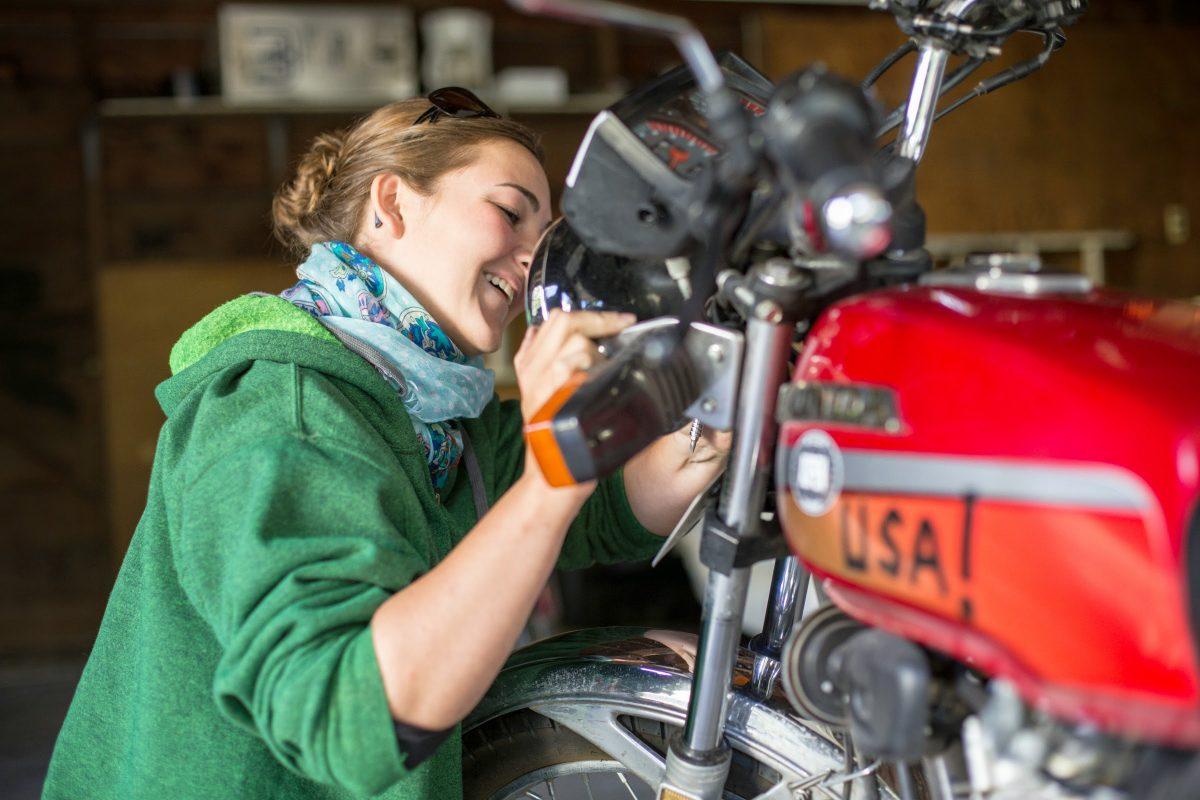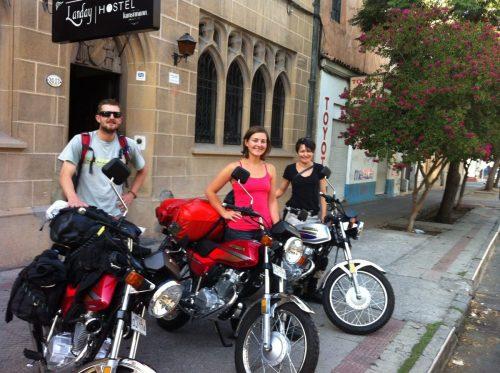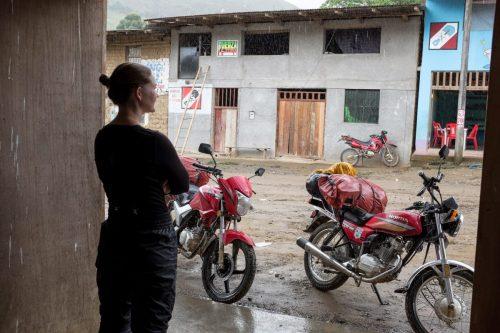
The Financial Life of an Adventuress, Exposed! Budget Tips and the True Cost of Riding Latin America
BY ELISA WIRKALA
In January, 2014, I set out to ride the Americas on a Honda CGL125. Trying to stick to a daily budget of $30USD was hard, but very doable.
Though finances were tight, the 20,000 mile ride across the Americas went off without a hitch. As the real beginning of the RTW, it’ll always be near and dear to my heart. But there are so many ride reports out there that I won’t go into the specifics of the trip itself. Instead, I’ll answer a question I get all the time: How much does a trip like that cost? Let’s crunch the numbers!
From January 1st to February 18th, 2014, I spent most of my time in Chile, one of Latin America’s most expensive countries. It compares to the States in cost, with a coffee costing as much as $4USD, a dorm bed $20, and a camp spot as much as $15. In 49 days I spent $1,393, or a daily average of $28.50USD, less than my self-imposed $30/day budget. That’s $855/month for all my living, travel and motorcycle costs, which leaves an extra $200 in my pocket for unforeseen expenses. It’s also less than I’d spend if I were just hanging around home paying my own mortgage, bills, food, gas, and outings.

In order to travel on $30/day, it’s necessary to decide what’s important to you, and what isn’t. The rest, you do without. I cut most alcoholic beverages, expensive tourist attractions (save a few of the big ones, like Machu Picchu), and fancy gear purchases. If you’re on a tight budget, plug the slow leak of money that goes towards things that don’t buy happiness.
The math and routine is simple enough. Break your daily expenses into three main categories: $10/food, $10/shelter, $10/fuel. Choosing a fuel efficient and economic motorcycle makes a huge difference in finance, though sometimes requires patience and strength of mind and body to get you all those miles through such tough terrain.
On a CGL125, you’ll likely only spent $5-15/day on fuel, traveling some 100 miles a day over the really hard terrain, and likely not over 500 miles a day on the easy stretches of highway (a brutal exercise on a 125cc bike). Rest days help lower the cost of fuel, and free camping in places like Patagonia lower the cost of lodging. The money saved in fuel on rest days often goes towards the cost of motorcycle maintenance, which is very cheap on a bike like the CGL.
If you avoid touristy restaurants, $10 a day on food is easy, and if you travel relatively slowly, you don’t burn through your daily fuel budget.
Spending $30/day isn’t so hard when you get used to it, though there is an adjustment period. But what happens when you factor in the big expenses?
Seattle to Santiago/Bogota to Seattle flights: $1,242 (r/t out of Bogota in case I wanted to bail early)
New Honda CGL 125: $1,400 with taxes and all paperwork in Santiago de Chile
Argentina and Chile Reciprocity visa fee for Americas: $320
= Base cost: $2,962 for bike, flights and visas
At $28.50/day ($855/month), plus the above costs, your monthly and daily costs could be as little as:
$3,817 for one month of traveling, or $127/day
$4,672 for two months of traveling, or $78/day
$5,527 for three months of traveling, or $62/day
$9,802 for 8 months of traveling, or $40/day
Other expenses to factor in would be things like travelers insurance (I paid $300 for 6 months). If you’re thinking of traveling the length of the Americas, make sure to factor in the impassable Darien Gap. I paid $1,400 for the bike and myself to fly from Medellin to Panama City. I’d recommend taking a sailboat, which wasn’t possible for me at the time due to a change in Panamanian regulations. In 2014, sailing cost roughly $500 for the bike, and $500 per person on the 4-5 day sail from Cartagena, Colombia to Colon, Panama.
A few money-saving tips for the road:
TIP #1: If you’re planning on selling your bike somewhere in the Americas, use Horizons Unlimited to post your bike for sale. There are many travelers looking for a bike who are heading back towards the bike’s country of origin. At a minimum, you can easily recoup half the value of the bike, if not more. Detailed bills of sale and receipts in Spanish can be found at many business shops in Latin America, giving the next motorcycle traveler less of a headache at boarder crossings.
Tip #2: Round trip tickets are usually only slightly more expensive than one-way tickets, sometimes even cheaper. Use Google’s new flight search for the best tickets, and avoid buying from third party companies as they’re generally unhelpful when trouble arises. Even better, open up a credit card that gives 40,000 bonus miles, often enough for a free one-way international ticket. Just remember to always pay off your monthly balance in full so as not to pay interest.

Tip #3: Don’t believe the naysayers about small displacement motorcycles. Sure, a small bike can be uncomfortable, but it does the job in a (cheap) pinch, and parts are everywhere. It’s also a way to blend in better with locals. I’ve seen 6’3 men ride CGLs for thousands of mile, and so can you. And if you’re afraid of traveling alone and sticking out like a sore thumb, avoid the flashier bikes regardless of budget. Small bikes are also easier to get up and down stairs and into hotel rooms, a common practice throughout Latin America. They’re easier to pick up out of the Bolivian sand or Amazonian muck, too. And if it does get stolen, it likely won’t break the bank.
Tip #4: Spend less time in the more expensive countries like Chile, Costa Rica and Mexico if possible. Want more time in those more expensive places? Minimize costs by camping, making your own food and coffee, do work exchanges or WOOFing for a few weeks, or stay with friendly folks from Couchsurfing.com. Even a few extra bucks a day really add up.
Tip #5: Don’t splurge on accessories: Use the stuff you have, buy a cheap set of raingear for over the top, and get a few paper maps bef0re leaving home, as they can be difficult to find in some Latin American countries.
Ultimately, I spent more than the numbers above, but not by a lot. I ended up buying a second motorcycle in southern Chile (a 125cc Honda Storm new for $1,900) and invited a handful of friends to join me in stages. I eventually sold the second bike in Medellin for half of what I paid, once my supply of adventuresome friends ran dry. Though costly, giving my friends the chance to ride some of South America with me was worth every penny.
Don’t have a lot of money? Don’t worry! There are plenty of people traveling frugally, and you can do the same.
Have questions about riding the Americas? Post them in the comments below and we’ll help you out!
*Read the full story of the CGL adventures at Travelbugblues.com.
Photo credits to Justin Herx

3 comments
Awesome stuff! I agree, smaller bikes are way less hassle and you just breeze on by as if you were a local! Safe travels!
Dags
Thanks!
What an interesting article. You’ve definitely given me the courage to start planning cross-country bike trip. Now all I have to do is save up some funds. Will definitely consider your pointers to try and stay within budget. Thanks for the suggestions.